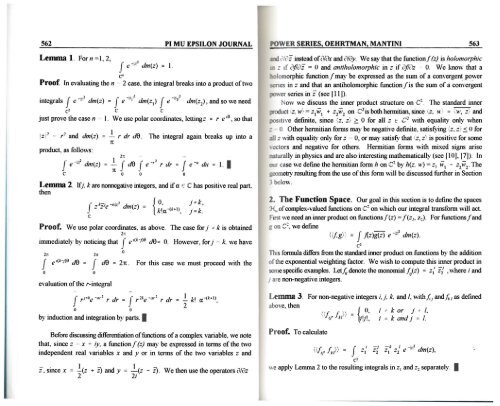Vol. 10 No 7 - Pi Mu Epsilon
Vol. 10 No 7 - Pi Mu Epsilon
Vol. 10 No 7 - Pi Mu Epsilon
Create successful ePaper yourself
Turn your PDF publications into a flip-book with our unique Google optimized e-Paper software.
562 PI MU EPSILON JOURNAL<br />
Lemma 1. For n =I~ 2,<br />
f . '12 e -,= dm(z) = 1.<br />
C''<br />
Proof In evaluating then -- 2 case. the integral breaks into a product ofnvo<br />
integrals .f e -!:1 2 dm(z) = I e -I=/ dm(z ) 1<br />
I e -l= 212<br />
dm(z ), 2<br />
and so we need<br />
c2 c c<br />
just prove the case n -- I. We usc polar coordinates, lettingz = r e ' 6 , so that<br />
lz1 2 - r 2 and dm(z)<br />
product, as follows:<br />
j<br />
I<br />
- r dr de . The integral again breaks up into a<br />
1t<br />
2n · "'<br />
. e -= I 12 dm(z) = -:; I j' de j' e -r 2 r dr = j' e -u du = 1. I<br />
c 0 0 0<br />
Lemma 2. If), k are nonnegative integers, and if ex :. C has positive real part.<br />
then<br />
. l ' :;=k '<br />
j=k.<br />
Proof. We use polar coordinates. as above. The case for j ~ k is obtained<br />
2n<br />
immediately by noticing that I e l(k-;)6 de = 0. However, for j ~ k, we have<br />
0<br />
2n<br />
2n<br />
I e' =
















